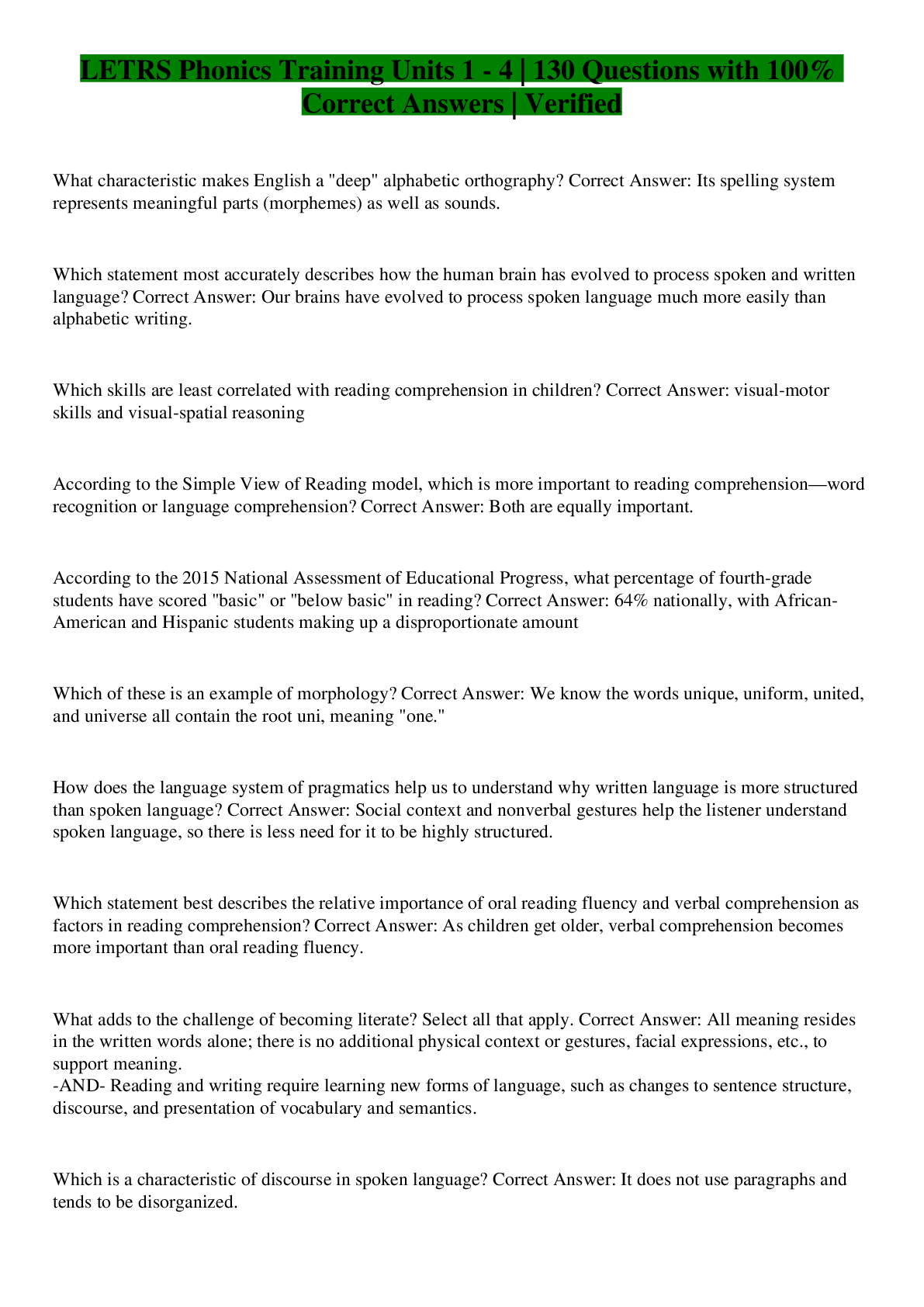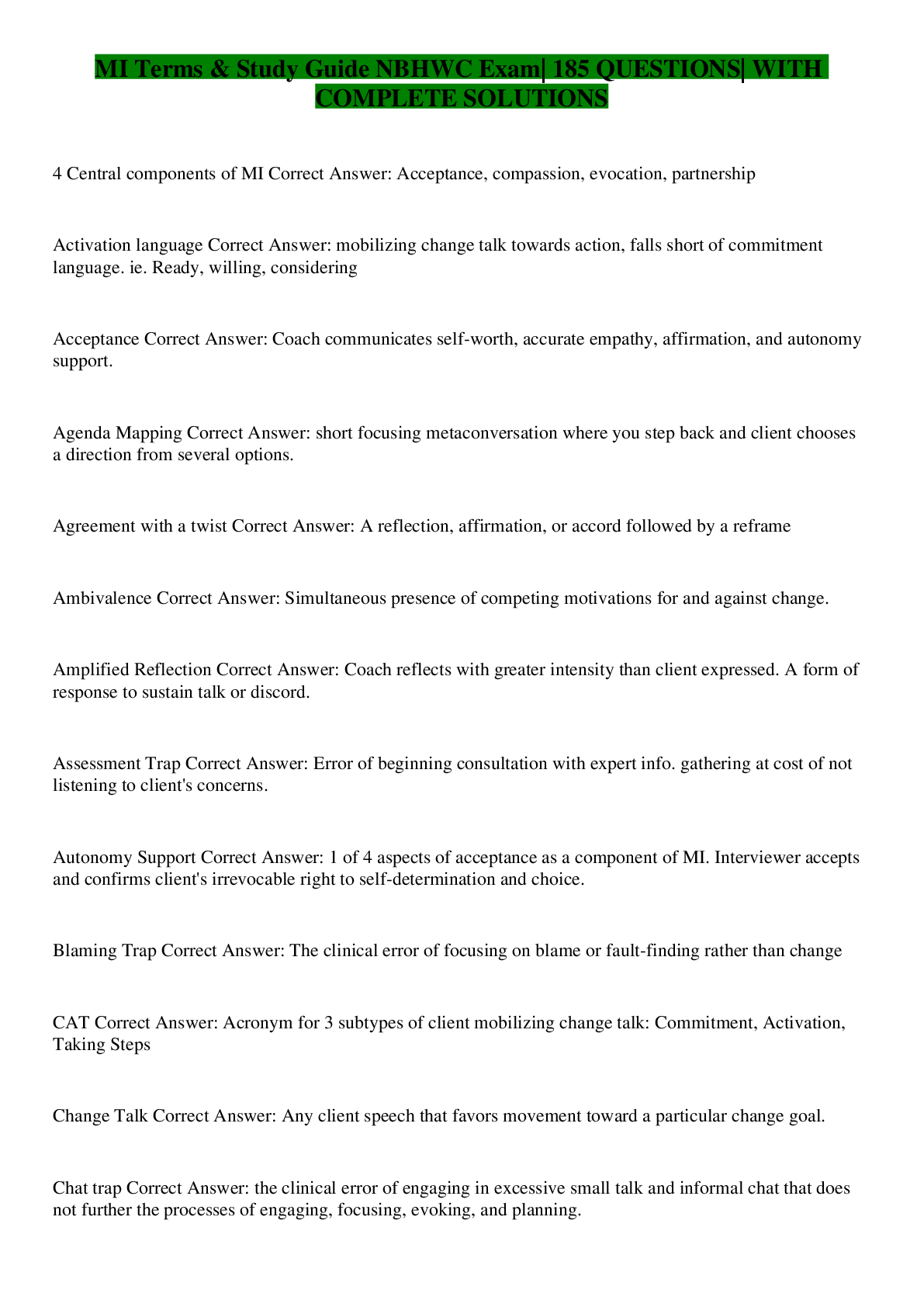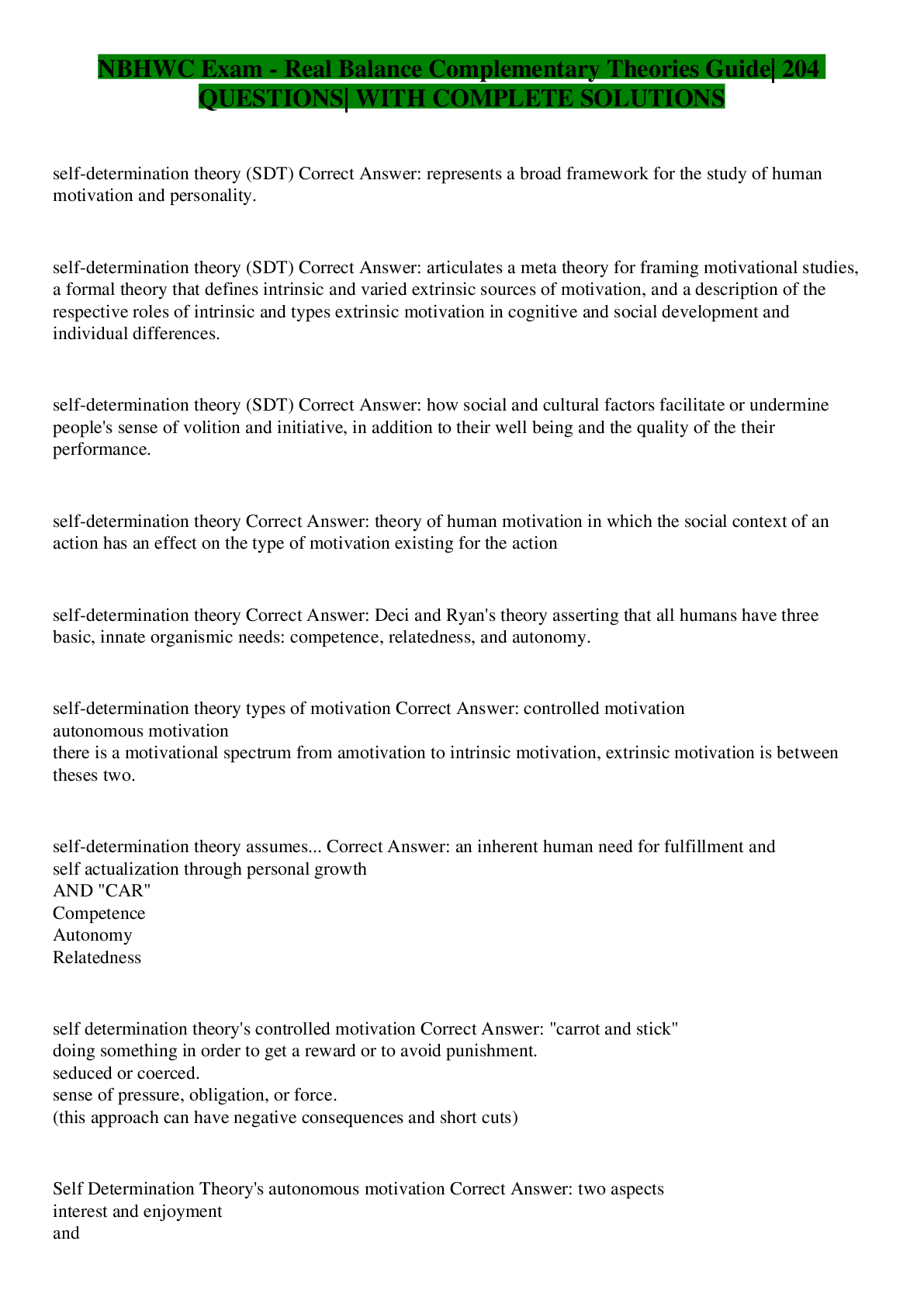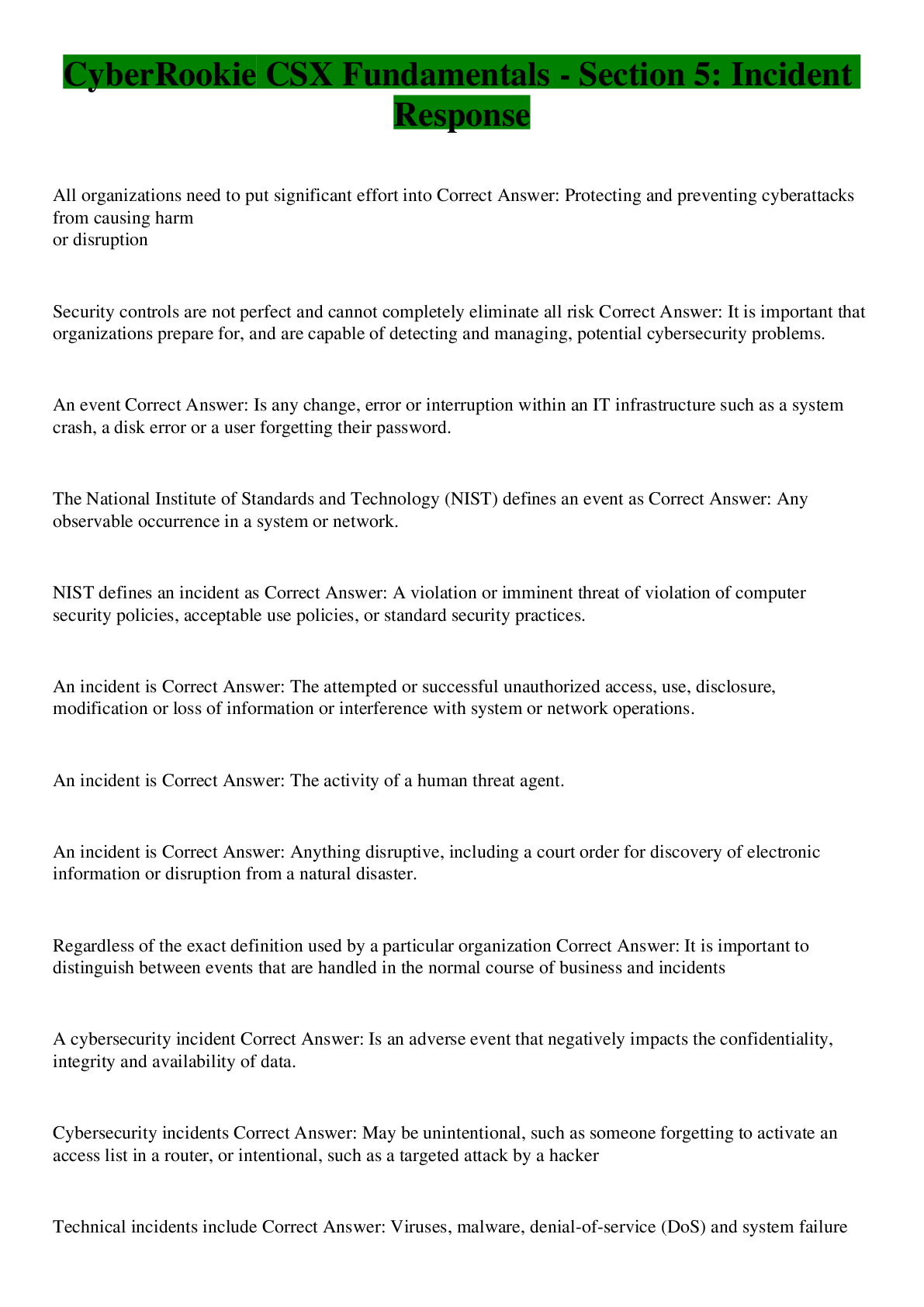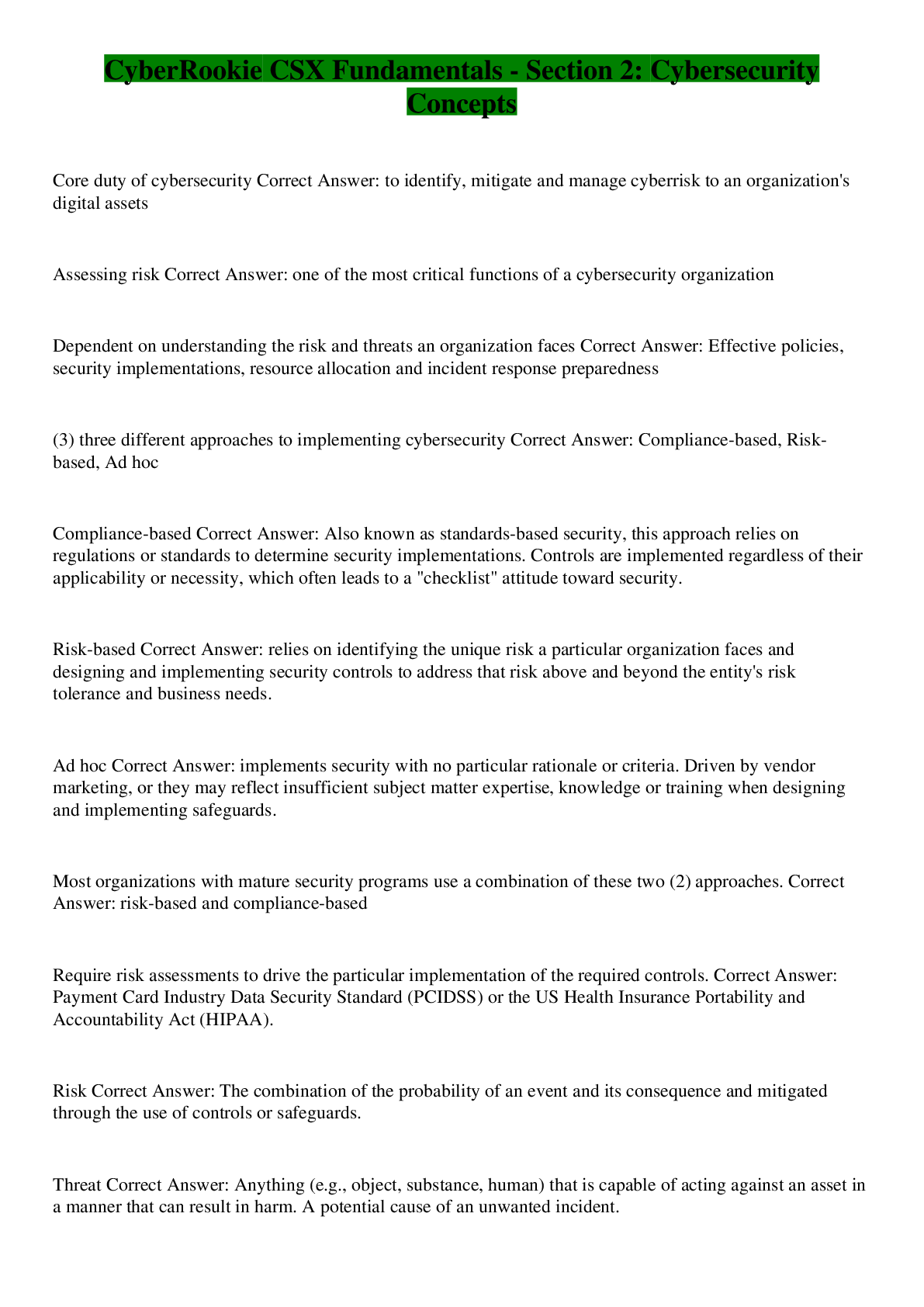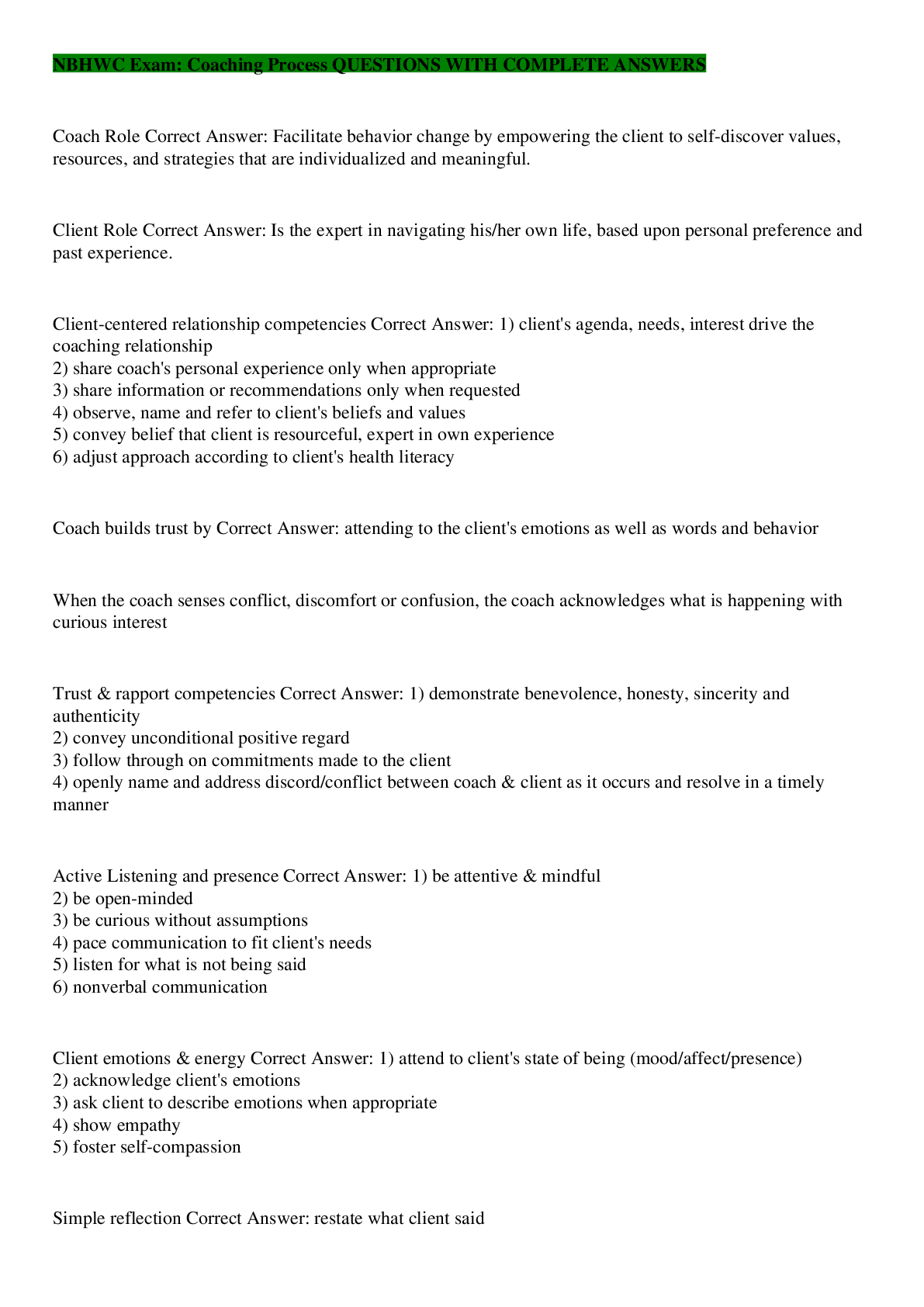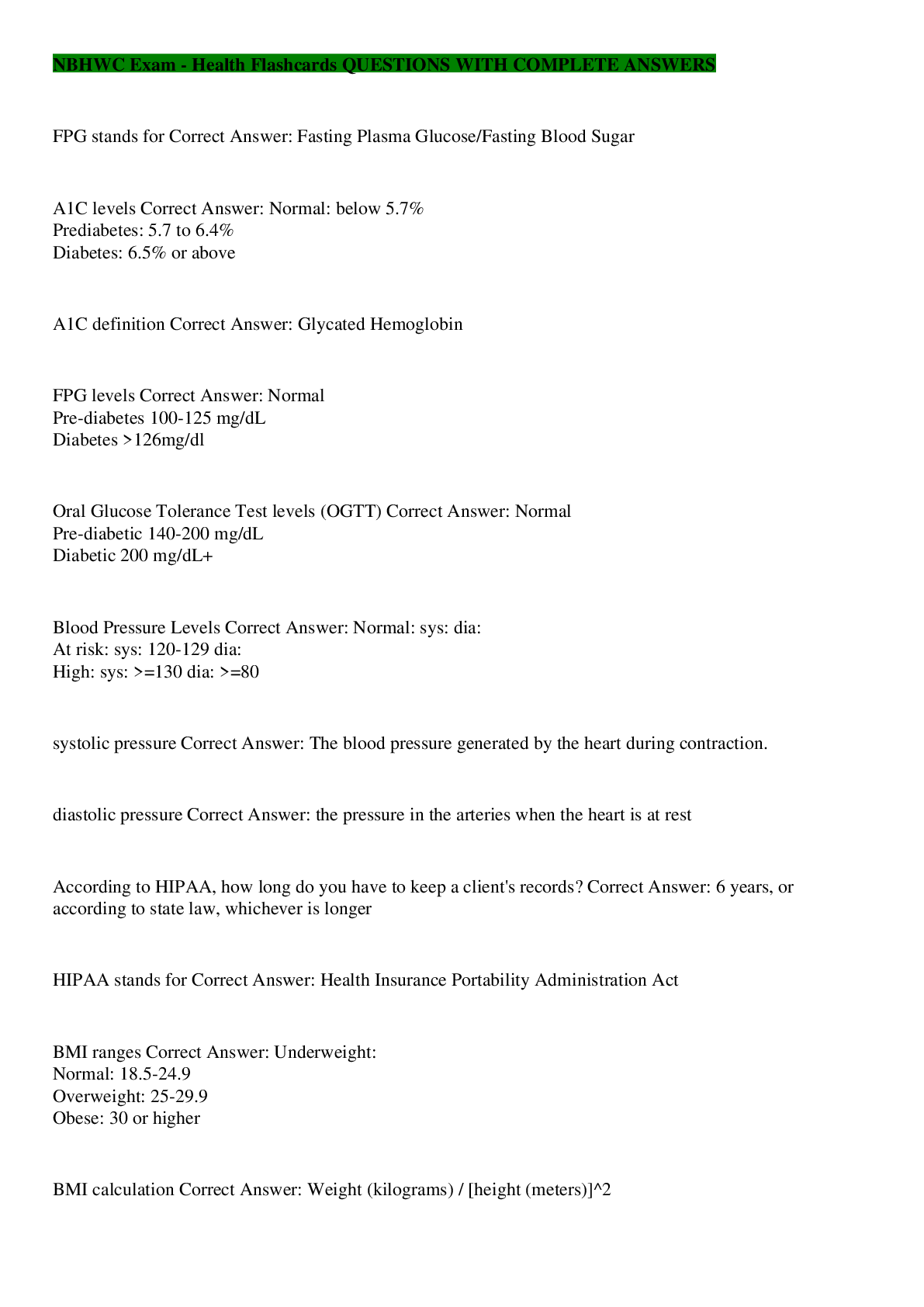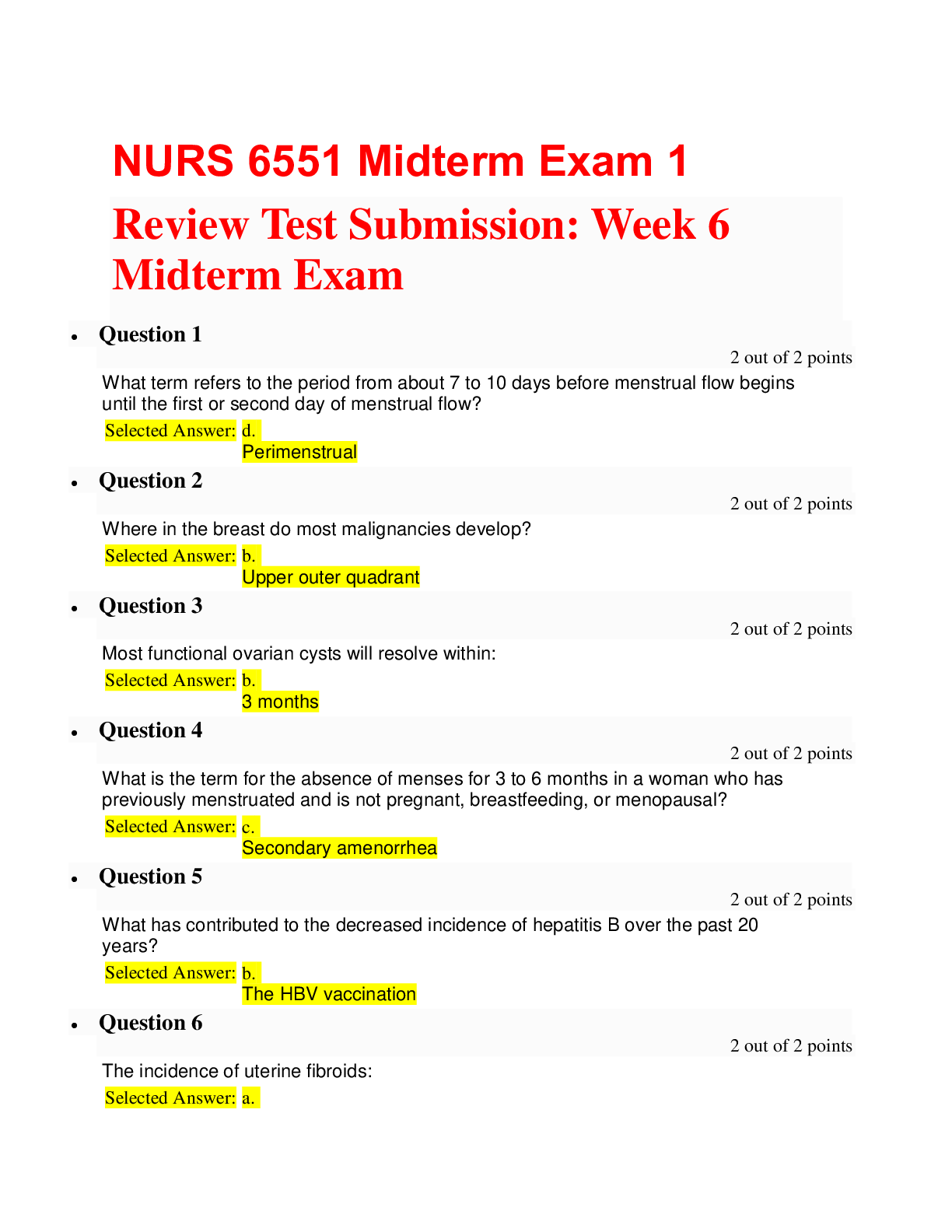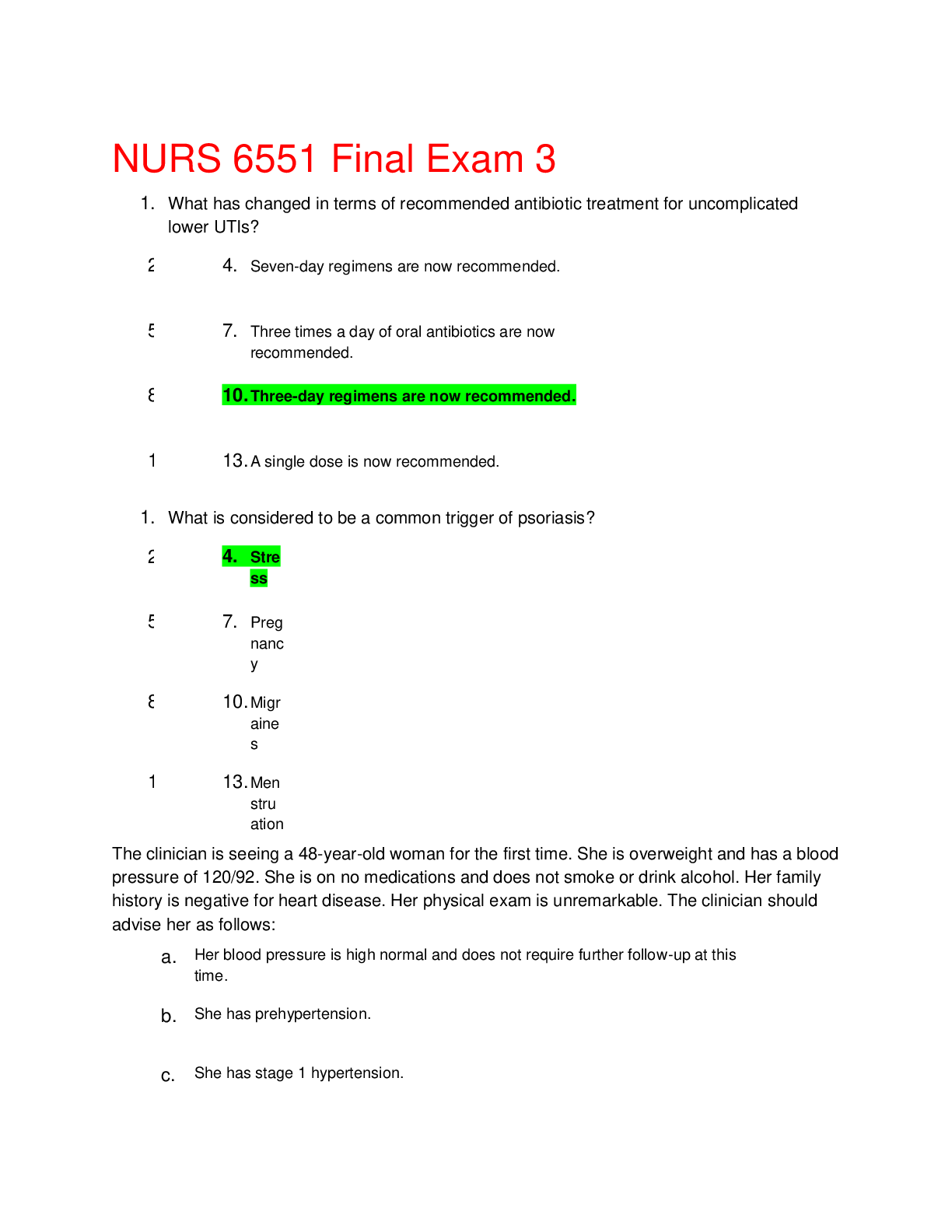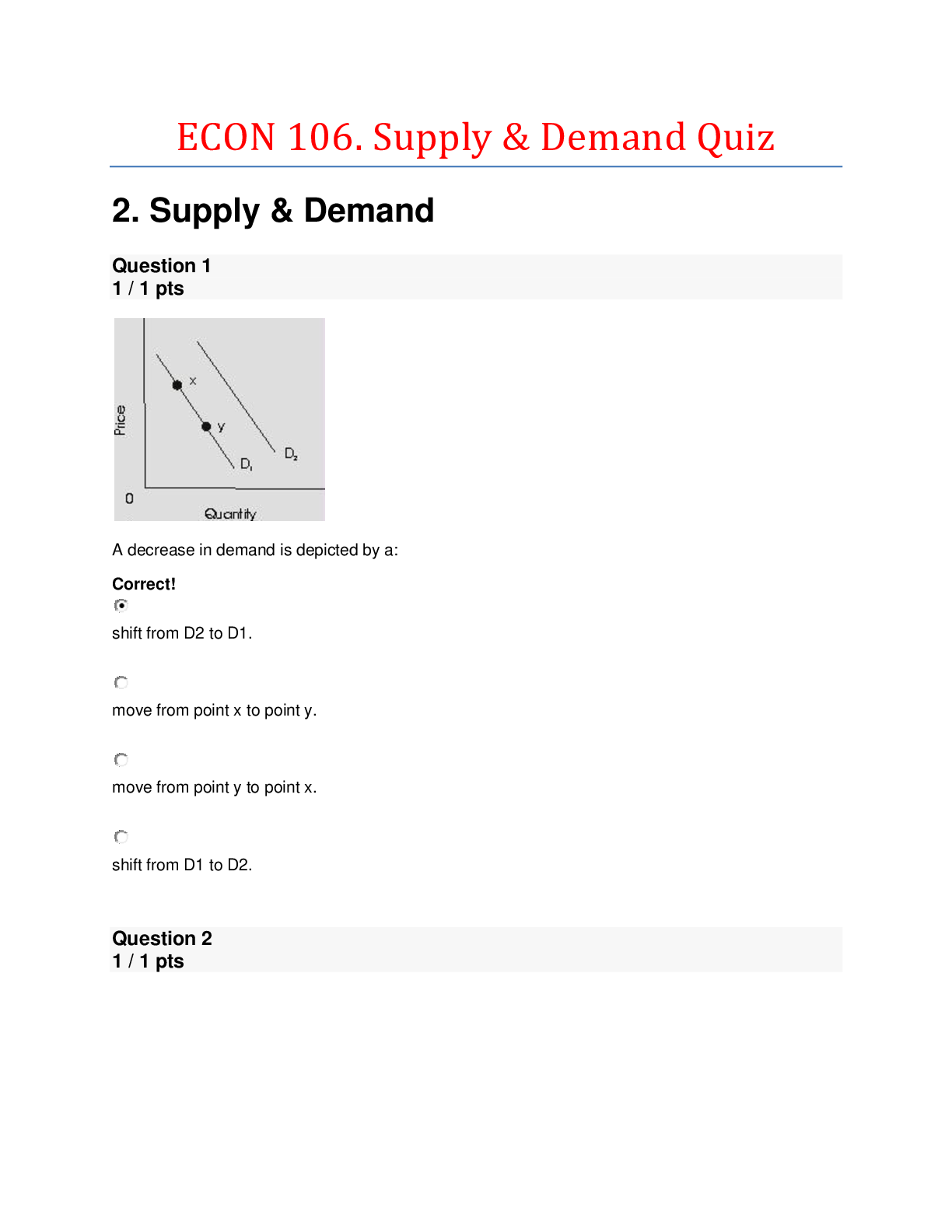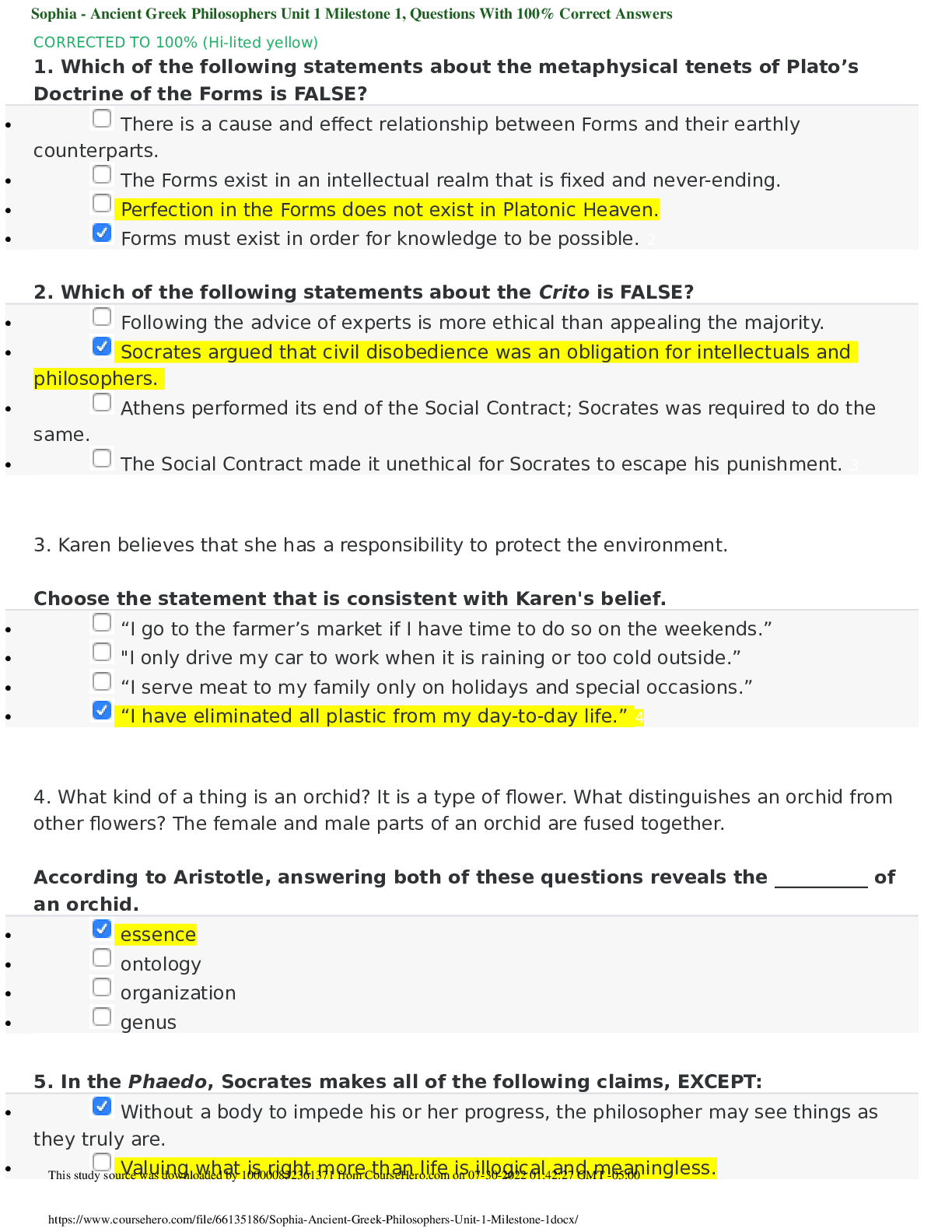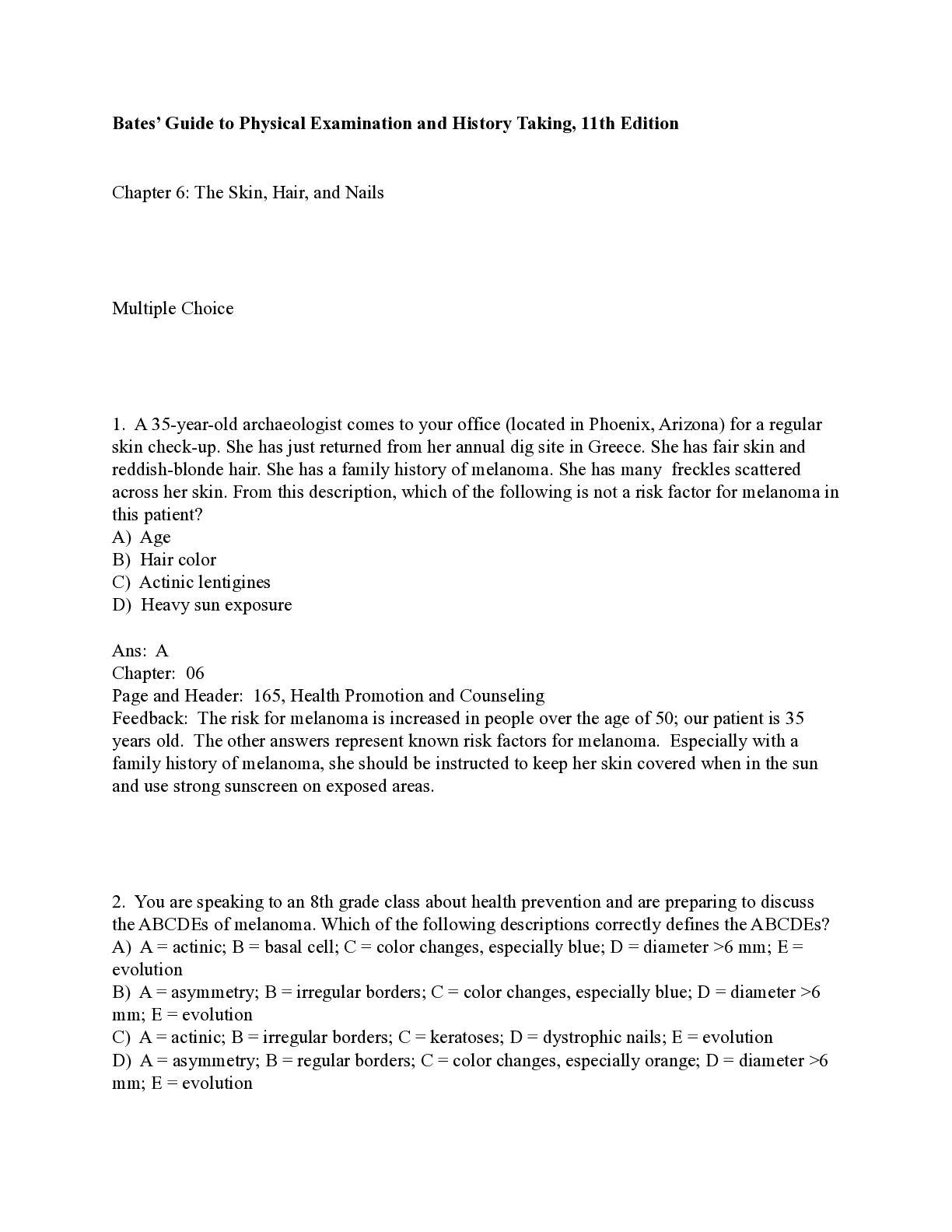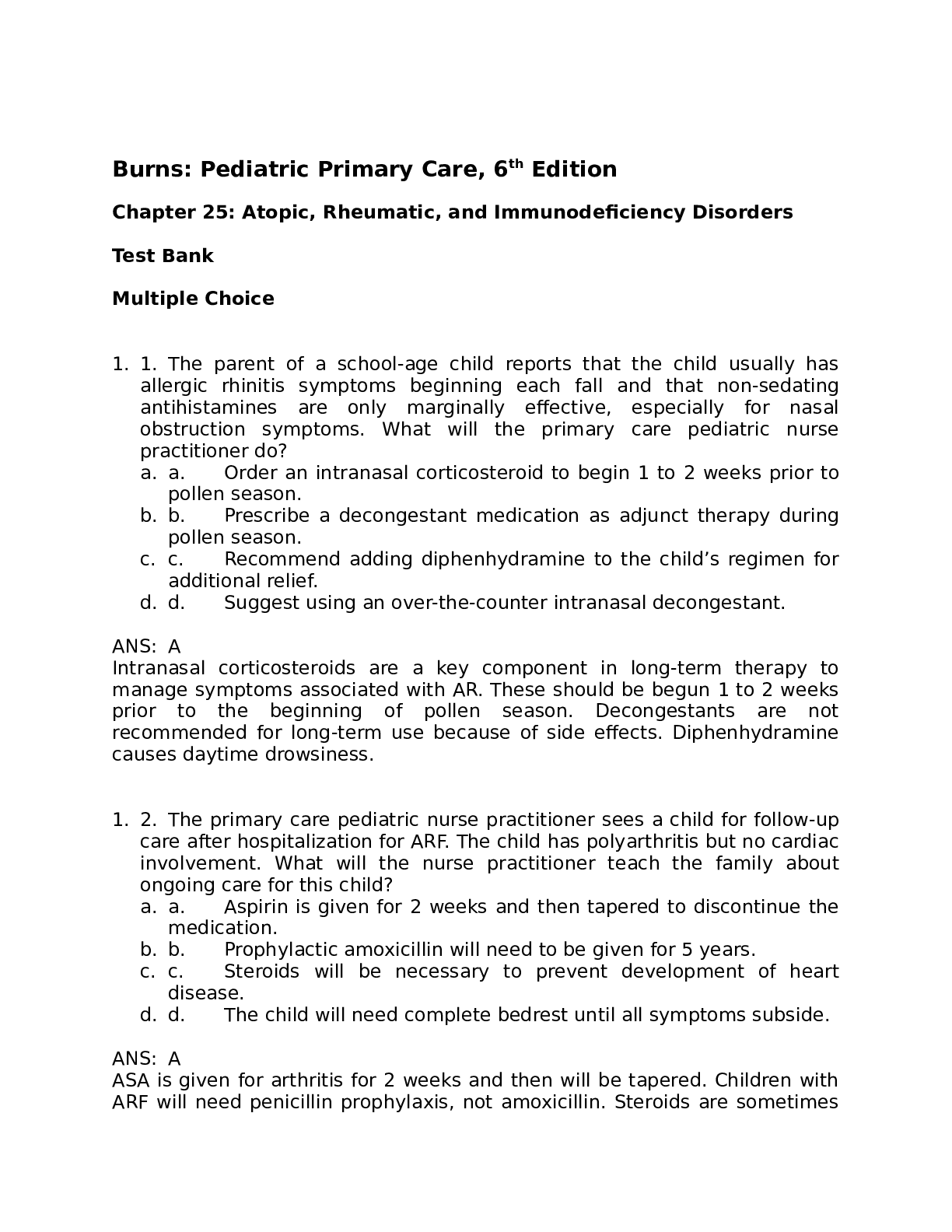Health Care > EXAM > PANCE Practice Exam – With COMPLETE SOLUTION 300 Questions with 100% Correct Answers (All)
PANCE Practice Exam – With COMPLETE SOLUTION 300 Questions with 100% Correct Answers
Document Content and Description Below
A 27-year-old woman complains of years of menstrual irregularity and increasing facial and chest hair. PMH: significant for ovarian cyst and left cytectomy. She is a non-smoker and non-drinker. Labs i... nclude a negative uCG, elevated LH, and low FSH. She desires fertility and she has not responded to three cycles of clomiphene. What would be the next choice of medication that may return ovulation? A. Insulin B. Metformin C. Dexamethasone D. Spironalactone E. Finasteride - ✔✔The answer is B. EXPLANATION: Dexamethasone, finasteride, and spironalactone all treat symptoms of hirsutism, but do not treat the underlying cause of PCO or improve fertility outcomes. PCO has an underlying insulin resistance that can be treated with oral hypoglycemics and improve sensitivity to insulin. Adding insulin does not improve the resistance. A 2-week-old male infant presents for a routine checkup. The mother complains that he nurses every hour, but vomits (nonbilious) after every time he eats. He has only had three bowel movements since he has been home. On examination, the infant has not gained any weight since leaving the hospital, and the clinician notes gastric peristaltic waves. Which of the following is the treatment of choice for this patient? A. pyloromyotomy B. metoclopramide C. laparotomy D. omeprazole - ✔✔The answer is A. EXPLANATION: This infant is presenting with signs and symptoms of pyloric stenosis. Infants typically have vomiting (projectile at times) after every feeding and it normally starts between the age of 2 and 4 weeks. The infant nurses fervently and is hungry. In addition, there may be dehydration, constipation, weight loss, and apathy. Abdomen may be distended with gastric peristaltic waves. Occasionally, an olive-sized mass can be felt in the right upper quadrant with deep palpation after the child has vomited. Vomitus is typically nonbilious. Diagnosis is confirmed by an upper gastrointestinal series with delayed gastric emptying, enlarged pyloric muscle, and characteristic semilunar impressions on the gastric antrum. In addition, an ultrasound is needed to verify the hypertrophic muscle. The treatment of choice for these patients is pyloromyotomy, which can be done laparoscopically. These patients make full recoveries and have an excellent prognosis.Upon performing a newborn examination, the clinician notes a widened pulse pressure, paradoxical splitting of S2, and a "machine"-like murmur heard best at the second intercostal space, left sternal border, and inferior to the clavicle. Which of the following is the most likely diagnosis? A. tetralogy of Fallot B. ventricular septal defect C. atrial septal defect D. patent ductus arteriosus - ✔✔The answer is D. EXPLANATION: Patent ductus arteriosus (PDA) is an isolated abnormality that occurs in infants. The ductus arteriosus is a normal fetal vessel that joins the aorta and the pulmonary artery and spontaneously closes after 3 to 5 days. Lack of closure results in the audible murmur that is "machinelike" and maximal at the second intercostal space (ICS), at the left sternal border (LSB), and inferior to the clavicle. It is typically a pansystolic murmur with bounding pulses and a widened pulse pressure. There is also a paradoxical splitting of S1 and S2. Echocardiography confirms the PDA, the direction and degree of shunting, and the presence of lesions for which the PDA is needed to keep. If there are no other cardiac malformations requiring the PDA, then if the PDA is large, surgery should be completed before 1 year of age. Symptomatic PDAs that are relatively small may be closed with indomethacin in preterm infants. an ejection type, systolic murmur heard best at the LSB, second ICS with a wide, fixed S2 and normal pulses. - ✔✔atrial septal defect (ASD) a harsh, pansystolic murmur heard best at the third and fourth ICS. With increasing size, heaves, thrills, and lifts are present along with radiation throughout the chest. - ✔✔Ventricular septal defect (VSD) a rough ejection, systolic murmur heard best at the LSB and the third ICS with radiation to the back. - ✔✔Tetralogy of Fallot A 42-year-old woman, with a history of struvite renal calculus, calls the office with a complaint of a urinary tract infection. As part of the interview, she reports intermittent, mild right flank pain for 4 days. Her urine dipstick is positive for microscopic hematuria, and the urine pH is 7.5. The KUB film is positive with two visible stones in the right kidney. Which of the following organisms is most likely to be cultured from the urine specimen? A. Escherichia coli B. KlebsiellaC. Proteus D. Chlamydia trachomatis - ✔✔The answer is C. EXPLANATION: This patient has struvite stones. They are frequently associated with recurrent urinary tract infections, visible stones, and high urine pH. These stones are formed by urease-producing organisms including Proteus and Pseudomonas while being caused less commonly by Klebsiella. Struvite stones are not typically caused by E. coli and C. trachomatis. A 33-year-old woman treated with trifluoperazine for the past 3 months is seen in the emergency department because of recent-onset fever, stiffness and tremor, as reported by her accompanying sister. The patient also appears to be mildly confused when asked about location, day, and time. Her temperature is 104.5°F, and her serum creatine kinase (CK) level is markedly elevated. Which of the following has most likely occurred? A. a delayed allergic reaction has occurred with trifluoperazine B. tardive dyskinesia has begun to develop in the patient C. the patient has developed neuroleptic malignant syndrome D. the patient has developed serotonin syndrome E. the patient has overdosed on trifluoperazine - ✔✔The answer is C. EXPLANATION: Neuroleptic malignant syndrome is an uncommon but serious complication with therapeutic doses of antipsychotic drug therapy, particularly the first-generation (typical) class. Cardinal signs and symptoms include a body temperature above 100.4°F, altered state of consciousness, autonomic dysfunction, and rigidity. A 48-year-old man presents to the clinic for a routine employment physical. The patient is asymptomatic. A pre-employment CBC reveals hemoglobin of 13.2g/dl, hematocrit of 39.5%, and MCV of 60.6 fL. Subsequent iron studies, hemoglobin electrophoresis, and sickle cell screening are "normal." After the labs are reviewed, the patient states "they are always normal." Which of the following is the most appropriate management for this patient? A. Bone marrow aspirate B. Ferrous sulfate daily C. Folic acid supplements D. Reassurance E. Refer to an oncologist - ✔✔The answer is D.EXPLANATION: The patient has a mild anemia with pronounced microcytosis consistent with alpha thalassemia minor and requires reassurance. Alpha thalassemia minor hemoglobin electrophoresis reveals normal results. Patients with alpha thalassemia are often inappropriately advised to take iron supplements (B) and don't require iron, folic acid (C) or vitamin B12 supplements unless a coexisting deficiency is confirmed. Referral to an oncologist (E) and a bone marrow aspirate (A) aren't necessary for this patient. white blood cell count (WBC) reveals 14,800 mcL with more than 10% atypical lymphocytes. On physical examination you find significant yellowish-grey pharyngeal exudate, cervical lymphadenopathy as well as an enlarged spleen. Her rapid strep is negative. What should be your treatment of this patient? A. Begin treatment with cephalexin. B. Send out a back-up throat culture and begin treatment with cephalexin pending those results .C. Send out a back-up throat culture and hold treatment pending those results. D. Draw a Monospot test and treat the patient supportively pending the results, insuring that they avoid contact sports until a definitive diagnosis has been made. E. Draw an Epstein-Barr virus (EBV) IgG level and treat the patient supportively if positive. - ✔✔The answer is D. EXPLANATION: With this patient's presentation and a negative rapid strep test, other etiologies beyond group A beta-hemolytic strep should be seriously considered. In light of her symptoms including fatigue, her WBC, and that her significant other is having similar symptoms, infectious mononucleosis is highest on the differential diagnosis. A Monospot test would rule this possibility in or out. She should refrain from contact sports until her infection and any associated splenomegaly has resolved. barking" cough and a low-grade fever. She has some runny nose and her voice is somewhat raspy and hoarse. mild inspiratory stridor. What is the most likely etiology of this child's illness? A. Adenovirus B. Coxsackievirus C. Cytomegalovirus D. Parainfluenza virus E. Respiratory syncytial virus - ✔✔The answer is D. EXPLANATION: This child has the classic presentation for croup. Sixty-five percent of croup is caused by a parinfluenza virus infection. Adenoviruses tend to cause severe pharyngitis/tonsillitis with tender, enlarged cervical nodes (A), while Coxsackievirus is commonly associated with hand-foot-and-mouth disease. (B) Cytomegalovirus causes an infectious-mononucleosis-like picture. (C) RSV is more typically associated with bronchiolitis. (E)Glucose challenge testing to rule out gestational diabetes should be done when? A. Between 12 and 16 weeks gestation B. Between 16 and 20 weeks gestation C. Between 20 and 24 weeks gestation D. Between 24 and 28 weeks gestation E. Between 28 and 32 weeks gestation - ✔✔The answer is D. EXPLANATION: Routine surveillance for gestational diabetes of a pregnant women is between 24 and 28 weeks; it is not modified due to obesity or other risk factors for diabetes. Gestational diabetes is a hormone-mediated intolerance. Surveillance is modified in the presence of pre-existing diabetes A 45-year-old patient came in to see his health care provider today, to discuss the results of his last annual assessment. He was told that he had developed type 2 diabetes mellitus. One of the recommendations from the physician assistant included a visit to an ophthalmologist. The physician assistant was concerned after seeing new capillaries, macular edema, and fibrous tissue within the retina during his funduscopic exam. What type of ocular complication does this patient most likely have at this time? A. Background retinopathy B. Closed angle glaucoma C. Macular degeneration D. Diabetic cataracts E. Proliferative retinopathy - ✔✔The answer is E. The correct choice is E, proliferative retinopathy. The distinguishing factor in the patient's presentation, which signals this disorder, is the development of newly formed vessels. Proliferative retinopathy is the leading cause of blindness in the United States. Up to 20% of patients with type 2 diabetes have retinopathy at the time of diagnosis. Choice A, background retinopathy, or simple retinopathy includes retinal microaneurysms, hemorrhages, exudates, and edema, without new vessel formation. Choice B, closed angle glaucoma, is relatively uncommon in patients with diabetes, except after cataract extraction. Choice C, macular degeneration, is not associated with diabetes mellitus specifically. Choice D, diabetic cataracts, tends to occur in patients with diabetes earlier than the general population, and may correlate with the severity of the disease. A 32-year-old male presents to your office with the complaint of low back pain for 7 months. The patient states he was initially injured on the job while trying to lift a 50-pound barrel off a truck. He denies any paresthesias or bowel/bladder problems associated with the low back pain. The patient states that hehad been given NSAIDs and a muscle relaxer, followed by physical therapy treatments. X-rays that were taken 5 months ago were reported as normal. He was placed on light duty at that time. The patient has seen many practitioners who have "not helped him." Another person who works with this patient was at the clinic and stated the patient has had problems with one of his other coworkers. You consider trying the patient on an antidepressant first and then possibly sending him to a pain clinic if there is no success. What is the most likely diagnosis [Show More]
Last updated: 1 year ago
Preview 1 out of 66 pages
Instant download
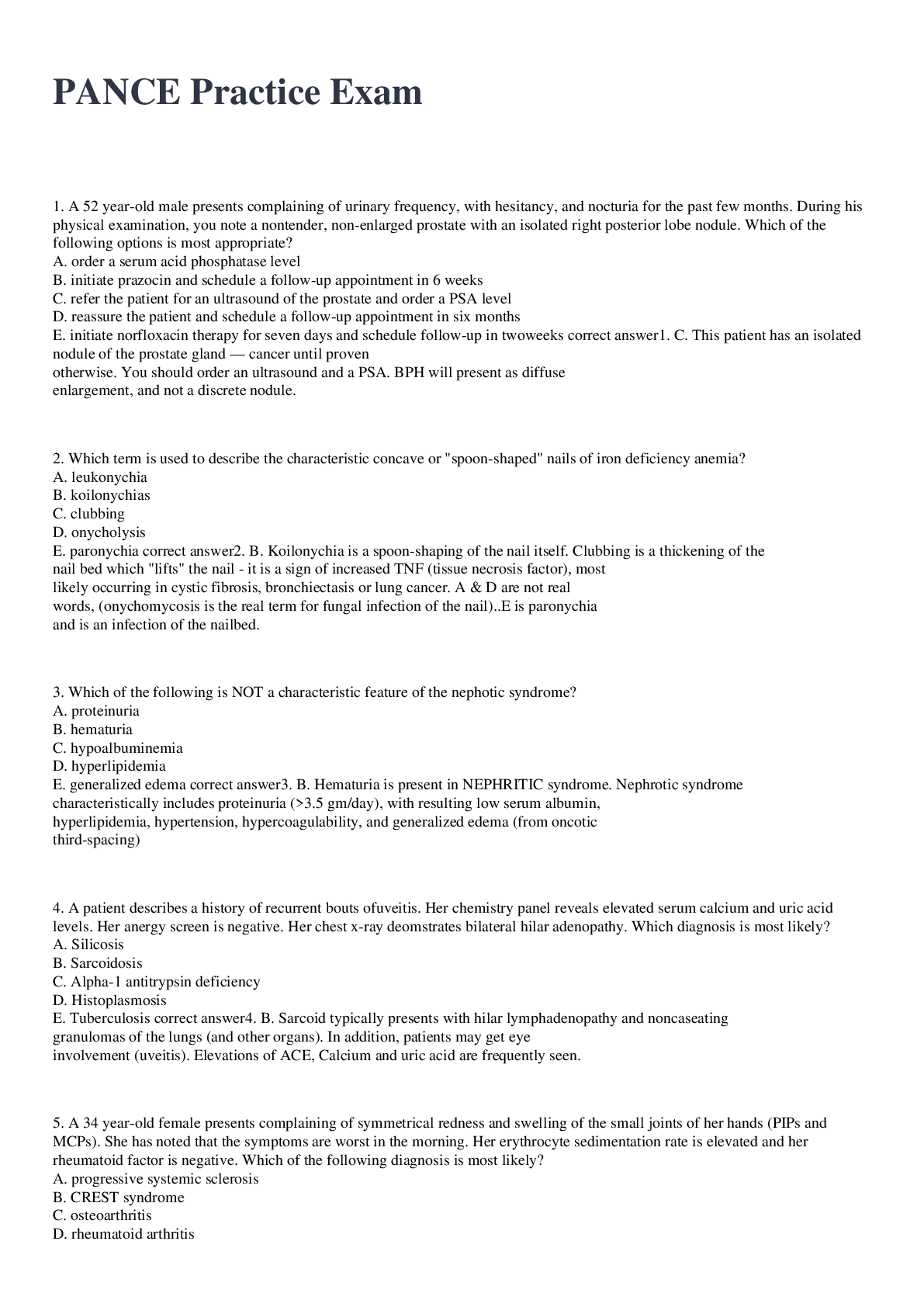
Buy this document to get the full access instantly
Instant Download Access after purchase
Add to cartInstant download
Reviews( 0 )
Document information
Connected school, study & course
About the document
Uploaded On
Sep 21, 2022
Number of pages
66
Written in
Additional information
This document has been written for:
Uploaded
Sep 21, 2022
Downloads
0
Views
29


